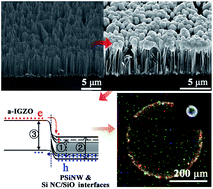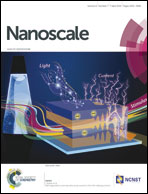White light emission from heterojunction diodes based on surface-oxidized porous Si nanowire arrays and amorphous In-Ga-Zn-O capping†
Abstract
A novel heterojunction white light emitting diode (LED) structure based on an array of vertically aligned surface-passivated p-type porous Si nanowires (PSiNWs) with n-type amorphous In-Ga-Zn-O (a-IGZO) capping is introduced. PSiNWs were initially synthesized by electroless etching of p-type Si (100) wafers assisted by Ag nanoparticle catalysts and then surface-passivated by thermal oxidation. The nanowires synthesized by metal-assisted electroless etching were found to have longitudinally varying nanoporous morphologies due to differences in the duration of exposure to etching environment. These PSiNWs were optically active with orange red photoluminescence consisting of dark red to yellow emissions attributable to quantum confinement effects and to modified band structures. The LED structures emitted visible white light while exhibiting rectifying current–voltage characteristics. The white light emission was found to be the result of the combination of dark red to yellow emissions originating from the quantum confinement effect within the PSiNWs and green to blue emissions due to the oxygen-deficiency-related recombination centers introduced during the surface oxidation.


 Please wait while we load your content...
Please wait while we load your content...